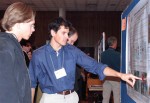The Shortgrass Steppe (SGS) LTER held its most recent biennial meeting on January 11 to discuss research and other issues of interest to the shortgrass steppe community. This year the symposium was structured around the theme "A Town Hall Meeting: Where is the Prairie Growing?" Presentations, discussions, and posters focused on changing land use on the grasslands and the impacts of shifting urban/rural boundaries.
Mike Antolin, co-PI of the SGS, welcomed the almost 200 participants on a very cold Colorado morning. Representatives from several educational institutions; private, commercial and non-government organizations; state and federal government agencies attended the symposium. Dave Theobold from the Department of Natural Resource Recreation and Tourism (NRRT) at Colorado State University gave the keynote talk on "Land Use Changes and the Urban/Rural Interface." Troy Florian and Larry Rogstad (Colorado Division of Wildlife) followed with a presentation on "Wind Farms, Wildlife and the Shortgrass Steppe." Peter Newman and George Wallace (NRRT), brought the morning session to a close with a joint presentation on their research on "Recreational Uses of the Pawnee National Grassland."
The afternoon session began with a presentation by Chris Pague (Nature Conservancy) on "Establishing Grassland Conservation Success," and closed with Dana Hoag and Catherine Keske (Department of Agricultural and Resource Economics, CSU) discussing "The Economics of Working Lands: Finding Harmony Between Humans and Nature on the Shortgrass Steppe Prairie." Their presentation included the results of a short survey that asked the symposium participants for feedback on the material presented during the day.
Each presentation was followed by lively question and answer periods moderated by members of the SGS LTER community. In true town hall meeting style the participants asked questions freely and provided input on the various topics under discussion. Some of the presentations are available on the SGS LTER website: http://sgs.cnr.colostate.edu/News/sgs_symposium_07/sgs_sym_agenda.htm.
Twenty-nine posters were presented in two sessions before and after an excellent southwest buffet lunch. Titles, authors, and most of the abstracts for the posters can be found on the SGS LTER website: http://sgs.cnr.colostate.edu/News/sgs_symposium_07/sgs_sym_07-poster_abstracts.html. Graduate student work was well represented in the poster sessions as was one REU (Research Experience for Undergraduates) project from the summer of 2006.
Gene Kelly, lead PI of SGS LTER, wrapped up the day's activities and invited everyone to a social hour for further discussions. After the symposium, SGS received many positive comments about all aspects of this year's program. One participant commented:
Two years ago, there were some good conversations about how the semi-annual meetings were attracting an increasing number of people interested in day to day management of grasslands. There was a feeling expressed that sometimes it is difficult to translate the results from some of the work by the LTER scientists into management practices. There was an honest response by the LTER staff that they had no immediate ideas how to better bridge the gap between science and practice (to the degree it exists), but a clear commitment to try. Well, you folks rounded up the right people to provide some insights into the practice of grassland conservation. I can't think of a better slate of speakers. The attendance this year was a reflection of the excitement the agenda generated. I thought back to my first visit to the workshop six (or was it eight?) years ago! What a difference. So thank you for responding to the feedback and request from folks who came two years ago.

 Enlarge this image
Enlarge this image